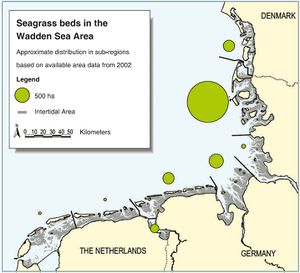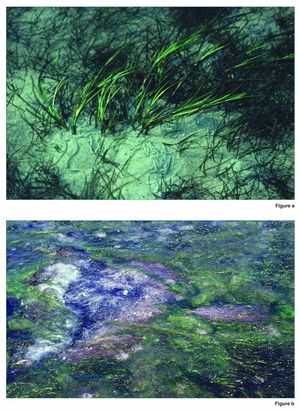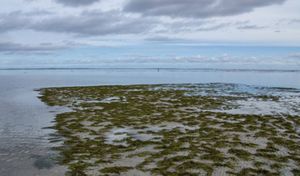Seagrass recovery and restoration in the Wadden Sea
Contents
Introduction
To measure ecological quality in the environment, powerful indicators are needed. In coastal waters seagrass has been suggested as a sensitive indicator for an overload of nutrient inputs from land use practices (Burkholder et al., 2005[1]). Losses of seagrass fields have occurred all over the world. Restauration initiatives have been undertaken in many places, with varying results. This has provided a better understanding of the conditions for success. However, the costs are high with current techniques; most of the recovery projects carried out to date are therefore small-scale (Paling et al. 2009[2].
In the Dutch and Lower Saxonian Wadden Sea seagrass beds have been in decline over several decades. A rough aerial survey in 2002 indicated the uneven distribution of seagrass between subregions within the Wadden Sea (Fig. 1). Seagrass was scarce in the south, while it was fairly common in the north. After measures to reduce nutrient emissions have lowered the discharge of nutrients into the coastal waters of the eastern North Sea, seagrass seems to be recovering (Reise et al., 2005[3]).The European Water Framework Directive requires a good ecological quality for all water bodies by 2015. For the North Sea coast, it is reasonable to use seagrass as an indicator to show when a good status has been reached. By using historical reference conditions from the Northfrisian Wadden Sea it has been estimated that good ecological quality comprises at least a 15 %-share of seagrass beds from the intertidal area. At present, seagrass beds cover about 90 km2, which corresponds to 10 %.
An assessment of seagrass occurrence across such a wide area of difficult accessibility is only feasible from the air. However, green algae constitute a challenge for this method. On satellite images (Brockmann and Stelzer, 2008[4]) and aerial photographs they are easily mistaken for seagrass. To distinguish between the two is essential, however, because contrary to the seagrass the opportunistic green algae respond to nutrient overloads with massive growth. This had happened twenty years ago when algal mats covered 15-20 % of intertidal flats in the Wadden Sea and smothered seagrass and the macrobenthic fauna underneath (Fig. 2) (Reise and Siebert, 1994[5]).
Survey
Each year, the Wadden Sea area is flown over at an altitude of 300 to 500 m in June, July and August during low tide exposure. In the course of summer, seagrass continuously grows denser while green algae appear to fluctuate. Both render the sediment surface darkish green. Only textural details indicate whether seagrass or green algae dominate. If a distinction cannot be made at first sight, questionable areas are flown over twice or more to reveal more structural features from different angles. If this does not help either, these problematic areas have to be visited by foot.
During flights notes are taken onto maps 1 : 100.000 made from satellite images to ease orientation over light (sandy) and dark (muddy) tidal flats dissected by branching creeks. Back on the ground, data are transferred to digital maps. Areal sizes covered by seagrass beds and green algal mats are calculated with a Geographical Information System (GIS).
Flying allows for rapid results but cannot replace ground observation entirely. Two species of seagrass occur in the region which differ in their indicatory value and can only be distinguished by experts (Fig. 2 a). Also, the species composition of green algal mats is variable, requires taxonomic expertise and provides information on the causes as well as the effects of massive green algal mats. Therefore, in the month of August, the entire region is surveyed area by area with trained personnel. This is very time consuming and the aim is to visit each area at least once within a period of six years.
The ecological quality will be evaluated over such six year intervals. This can level out fluctuations in seagrass bed area caused by unusual weather conditions or rough seas, and avoid mistaking inherent variability for environmental quality.
Seagrass recovery Northfrisian Wadden Sea
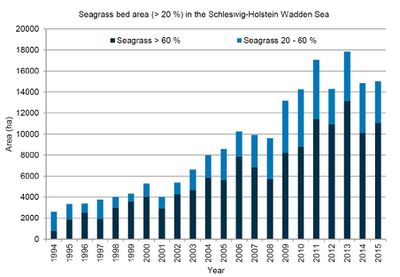
Areal sizes of seagrass beds assessed from the air have increased gradually in the intertidal of the Northfrisian Wadden Sea, particularly since this millennium has commenced (Fig. 3). This may be correlated with declining nutrient inputs. If these could be reduced further and seagrass increases accordingly, the requirement of the EU for a good ecological quality of coastal waters could be fulfilled in the coming years, based among other things on the status of intertidal seagrass beds.
However, in contrast to the south, in the northern region of the Wadden Sea there is no evidence from earlier decades for a retreat in seagrass in response to a nutrient over-supply. May the apparent recovery of seagrass have causes other than the reduction of nutrient input?
According to Weisse and Plüß (2006[7]) storm frequency in winter has increased since the 1960s and since the mid 1990s has decreased again. This is related to climatic oscillations in the Northern Atlantic. High water levels caused by storm surges in summer have declined slightly over the entire period. From field experiments it is known that seagrass is highly susceptible to sediment turnover as this may happen during storm surges (Cabaço und Santos, 2007[8]).
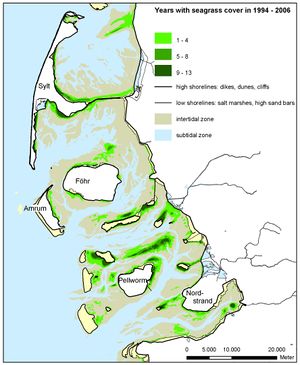
Looking at the spatial pattern of intertidal seagrass (Fig. 4), it is apparent that seagrass predominantly occurs at sites sheltered against the prevailing surf from the south western direction in the Northfrisian region (Reise and Kohlus, 2008[9]). In addition, field investigations have shown that the largest seagrass beds at the Halligen and the island of Pellworm are underlain by solid peat and clay in which seagrass roots get a fair hold. These observations support the assumption that sediment stability may serve as a key factor explaining why there is more seagrass in the Northfrisian region than in all the other regions of the Wadden Sea taken together (Fig. 1).
The pattern in Fig. 3 may also reflect an inverse relationship to storm frequency, which has declined since the mid 1990s. If this interpretation of seagrass occurrences is correct, than its future would be less a function of nutrient supply than of storm activity, and if the latter will increase again, and the last two winters do support just that, then seagrass will not achieve an areal share of 15 % as required for a good ecological quality status by the European Water Framework Directive.
A potential for further expansion of seagrass would be possible along the mainland coast if land reclamation works are phased out. These destroy seagrass beds in two ways. Between the brushwood fences traditionally set up in rectangular fields to calm down wave action, green algae tend to accumulate and then smother seagrass. Secondly, the digging of ditches in a grid-like pattern with the excavated material piled up between parallel ditches is detrimental to seagrass, either directly or by enhanced sedimentation within reclamation fields. These negative effects of land reclamation works on seagrass constitute a dilemma. The works are deemed beneficial for coastal protection if they are successful in building up a foreland to absorb wave energy in front of seawalls. In many cases, however, this aim is not achieved because of an insufficient sediment supply to the area. The net effect is merely an exclusion of seagrass beds and disturbance of other nearshore biota.
In the long run, it appears questionable whether seagrass beds could maintain their spatial share if sea level rise accelerates and storm activity will increase in the wake of global warming. Such a climatic effect is not yet considered in the Water Framework Directive but should better be taken into account.
Seagrass restoration southwestern Wadden Sea
The situation in the southern part of the Wadden Sea is less positive than in the northern part. Seagrass was widespread in the southern Wadden before 1930. After that, a rapid decline occurred and natural recovery has not taken place since (Giessen 1990[10]). Increased turbidity is thought to be a major cause; turbidity is probably enhanced by feedback from reduced sediment-trapping capacity (de Boer 2007[11]; Suykerbuyk et al. 2016[12]) and reduced NH4 removal by declining seagrass beds (Bulmer et al. 2018[13]). Other possible causes are an increase in fishing activity, dredging and an increase in eutrophication. In the 1990s, actions were initiated to reintroduce seagrass. The well-established rules for ecosystem restoration were followed as closely as possible (van Katwijk 2009[14]): (1) reversal of the presumed causes of eelgrass decline, in particular regarding fishing, dredging and eutrophication; (2) selection of suitable habitats, especially areas where seagrass used to be; (3) a donor population with suitable traits and sufficient genetic diversity; (4) trial fields of different spatial scales, variation in environmental conditions and differentiation in transplantation periods; (5) stabilization of the habitat by means of shell beds and mussel ridges. Despite these precautions, the reintroduced population has remained vulnerable. Instead of natural expansion, gradual decline has taken place. It is conjectured that the scale on which reintroduction took place was insufficient (van Katwijk 2016[15]). A reintroduction on a larger scale has been carried out in 2017 showing first promising results (Fig. 5).
Related articles
References
- ↑ Burkholder, J.M., Tomasko, D.A. & Touchette, B.W. (2007). Seagrasses and eutrophication. Journal of Experimental Marine Biology and Ecology, 350, 46-72.
- ↑ Paling, E.I., Fonseca, M., van Katwijk, M.M. and van Keulen, M. 2009. Seagrass restoration. In: Coastal wetlands , an integrated ecosystem approach. Eds. Perillo, M.E.m Wolanski, E., Cahoon, D.R. and Brinson, M.M., Elsevier Publ. Ch. 24
- ↑ Reise, K., Jager, Z., de Jong, D., van Katwijk, M. & Schanz, A. (2005). Seagrass. In K. Essink, C. Dettmann, H. Farke, K. Laursen, G. Lüerßen, H. Marencic, W. Wiersinga (Eds.), Wadden Sea Quality Status Report 2004, Wadden Sea Ecosystem 19 (pp. 201-207). Wilhelmshaven: Common Wadden Sea Secretariat.
- ↑ Brockmann, C. & Stelzer, K. (2008). Optical remote sensing of intertidal flats. In V. Barale & M. Gade (Eds.) Remote sensing of the European Seas, in press.
- ↑ Reise, K. & Siebert, I. (1994). Mass occurrence of green algae in the German Wadden Sea. Deutsche Hydrographische Zeitschrift, Supplement, 1, 171-180.
- ↑ Dolch, T., Folmer, E.O., Frederiksen, M.S., Herlyn, M., van Katwijk, M.M., Kolbe, K., Krause-Jensen, D., Schmedes, P. and Westerbeek, E.P. 2017. Seagrass. In: Wadden Sea Quality Status Report 2017. Eds.: Kloepper S. et al., Common Wadden Sea Secretariat, Wilhelmshaven, Germany. Last updated 21.12.2017. Downloaded 20.11.2018. qsr.waddensea-worldheritage.org/reports/seagrass
- ↑ Weisse, R. & Plüß, A. (2006). Storm-related sea level variations along the North Sea coast as simulated by a high-resolution model 1958-2002. Ocean Dynamics, 56 (1), 16-25.
- ↑ Cabaço, S. & Santos, R. (2007). Effects of burial and erosion on the seagrass Zostera noltii. Journal of Experimental Marine Biology and Ecology, 340, 204-212.
- ↑ Reise, K. & Kohlus, J. (2008). Seagrass recovery in the Northern Wadden Sea? Helgoland Marine Research, 62, in press.
- ↑ Giesen, W.B.J.T., van Katwijk, M.M. and den Hartog, C. 1990. Eelgrass condition and turbidity in the Dutch Wadden Sea. Aquatic Botany 37: 71–85
- ↑ de Boer, W.F. 2007. Seagrass–sediment interactions, positive feedbacks and critical thresholds for occurrence: a review. Hydrobiologia 591: 5–24
- ↑ Suykerbuyk, W., Bouma, T.J., Govers, L.L., Giesen, K., de Jong, D.J., Herman, P.M.J., Hendriks A.J. and van Katwijk, M.M. 2016 a. Surviving in changing seascapes: Sediment dynamics as bottleneck for long-term seagrass presence. Ecosystems 19: 296-310
- ↑ Bulmer, R.H., Townsend, M., Drylie, T. and Lohrer AM 2018. Elevated Turbidity and the Nutrient Removal Capacity of Seagrass. Front. Mar. Sci. 5: 462
- ↑ van Katwijk M.M., Bos A.R., de Jonge V.N., Hanssen L.S.A.M., Hermus D.C.R. and de Jong, D.J. 2009. Guidelines for seagrass restoration: Importance of habitat selection and donor population, spreading of risks, and ecosystem engineering effects. Marine Pollution Bulletin 58: 179–188
- ↑ van Katwijk, M.M., Thorhaug, A., Marba, N., Orth, R.J., Duarte, C.M., Kendrick, G.A., Althuizen, I.H.J., Balestri, E., Bernard, G., Cambridge, M.L., Cunha, A., Durance, C., Giesen, W,. Han, Q., Hosokawa, S., Kiswara, W., Komatsu, T., Lardicci, C., Lee, K.S., Meinesz, A., Nakaoka, M., O'Brien, K.R., Paling, E.I., Pickerell, C., Ransijn, A.M.A. and Verduin, J.J. 2016. Global analysis of seagrass restoration: the importance of large-scale planting. Journal of Applied Ecology 53: 567-578
Please note that others may also have edited the contents of this article.
|
Please note that others may also have edited the contents of this article.
|
